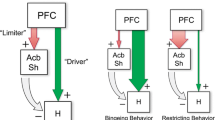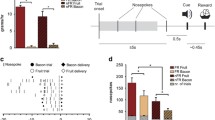Abstract
Rationale
Motivation for food depends on several variables including food palatability, the homeostatic state of the organism, and the nature of the behavior required to obtain the reward. However, few studies to date have tried to evaluate motivation for food considering all these variables at the same time. Since dopamine and opioids have been deeply involved in the regulation of feeding, it is of interest to investigate their role considering all the mentioned variables.
Objectives
In this study, we evaluated the involvement of dopamine and endogenous opioids on food consumption and food motivation using behavioral paradigms that differ in the motor requirement to gain access to the reward, when food palatability and homeostatic state were taken into account.
Materials and methods
Pellets differentiated on palatability were offered to sated and restricted rats in consummatory tests and in different behavioral paradigms measuring motivational state, but requiring different motor outputs (runway and an operant progressive ratio 3 task). Peripheral injections of naloxone or flupenthixol were administered when these tasks were learned and stable.
Results
Naloxone decreased food intake when pellets were palatable, while flupenthixol was without any effect. When considering motivation, naloxone decreased performances in both the runway and progressive ratio tests while flupenthixol was only effective in the progressive ratio test.
Conclusions
Impairing the opioid neurotransmission diminishes motivation to obtain food, possibly through a decrease in the perceived palatability of the food reward. The dopaminergic system appears to be more involved in the modulation of motivation to obtain food in a cost/benefit-related manner.






Similar content being viewed by others
References
Aberman JE, Salamone JD (1999) Nucleus accumbens dopamine depletions make animals more sensitive to high ratio requirements but do not impair primary food reinforcement. Neuroscience 92:545–552
Amalric M, Koob GF (1987) Depletion of dopamine in the caudate nucleus but not in nucleus accumbens impairs reaction-time performance in rats. J Neurosci 7:2129–2134
Arnold JM, Roberts DCS (1997) A critique of fixed and progressive ratio schedules use to examine the neural substrates of drug reinforcement. Pharmacol Biochem Behav 57:441–447
Barbano MF, Cador M (2005) Various aspects of feeding behavior can be partially dissociated in the rat by the incentive properties of food and the physiological state. Behav Neurosci 119:1244–1253
Barbano MF, Cador M (2006) Differential regulation of the consummatory, motivational and anticipatory aspects of feeding behavior by dopaminergic and opioidergic drugs. Neuropsychopharmacology 31:1371–1381
Barbano MF, Cador M (2007) Opioids for hedonic experience and dopamine to get ready for it. Psychopharmacology 191:497–506
Berridge KC (1991) Modulation of taste affect by hunger, caloric satiety, and sensory-specific satiety in the rat. Appetite 16:103–120
Berridge KC (1996) Food reward: brain substrates of wanting and liking. Neurosci Biobehav Rev 20:1–25
Carelli RM, Wolske M, West MO (1997) Loss of lever press-related firing of rat striatal forelimb neurons after repeated sessions in a lever pressing task. J Neurosci 17:1804–1814
Choi WY, Balsam PD, Horvitz JC (2005) Extended habit training reduces dopamine mediation of appetitive response expression. J Neurosci 25:6729–6733
Cleary J, Weldon DT, O’Hare E, Billington C, Levine AS (1996) Naloxone effects on sucrose-motivated behavior. Psychopharmacology 126:110–114
Collier G, Jennings W (1969) Work as a determinant of instrumental performance. J Comp Physiol Psychol 68:659–662
Collier G, Johnson DF (1997) Who is in charge? Animal vs. experimenter control. Appetite 29:159–180
Collier GH, Hirsch E, Hamlin PH (1972) The ecological determinants of reinforcement in the rat. Physiol Behav 9:705–716
Correa M, Carlson BB, Wisniecki A, Salamone JD (2002) Nucleus accumbens dopamine and work requirements on interval schedules. Behav Brain Res 137:179–187
Cousins MS, Salamone JD (1994) Nucleus accumbens dopamine depletion in rats affect relative response allocation in a novel cost/benefit procedure. Pharmacol Biochem Behav 49:85–91
Crespi LP (1942) Quantitative variation of incentive and performance in the white rat. Am J Psychol 55:467–517
Dickinson A, Balleine B (1994) Motivational control of goal-directed action. Anim Learn Behav 22:1–18
Dickinson A, Balleine B (2004) The role of learning in the operation of motivational systems. In: Pashler H, Gallistel CL (eds) Stevens’ handbook of experimental psychology, volume 3, Learning, motivation, and emotion. Wiley & sons, New York, pp 497–533
Dickinson A, Balleine B, Watt A, Gonzalez F, Boakes RA (1995) Motivational control after extended instrumental training. Anim Learn Behav 23:197–206
Gramling SE, Fowler SC, Collins KR (1984) Some effects of pimozide on nondeprived rats licking sucrose solutions in an anhedonia paradigm. Pharmacol Biochem Behav 21:617–624
Hayward MD, Pintar JE, Low MJ (2002) Selective reward deficit in mice lacking β-endorphin and enkephalin. J Neurosci 22:8251–8258
Hodos W (1961) Progressive ratio as a measure of reward strength. Science 134:943–944
Hursh SR (1980) Economic concepts for the analysis of behavior. J Exp Anal Behav 34:219–238
Ikemoto S, Panksepp J (1996) Dissociation between appetitive and consummatory responses by pharmacological manipulations of reward-relevant brain regions. Behav Neurosci 110:331–345
Kelley AE, Bakshi VP, Haber SN, Steininger TL, Will MJ, Zhang M (2002) Opioid modulation of taste hedonics within the ventral striatum. Physiol Behav 76:365–377
Kelley AE, Baldo BA, Pratt WE, Will MJ (2005) Corticostriatal–hypothalamic circuitry and food motivation: integration of energy, action and reward. Physiol Behav 86:773–795
Kimble GA (1951) Behavior strength as a function of the intensity of the hunger drive. J Exp Psychol 41:341–348
Levine AS, Weldon DT, Grace M, Cleary JP, Billington CJ (1995) Naloxone blocks that portion of feeding driven by sweet taste in food-restricted rats. Am J Physiol 268:R248–R252
Ljungberg T, Apicella P, Schultz W (1992) Responses of monkey dopamine neurons during learning of behavioral reactions. J Neurophysiol 67:145–163
McFarland K, Ettenberg A (1998) Haloperidol does not affect motivational processes in an operant runway model of food-seeking behavior. Behav Neurosci 112:630–635
Papaleo F, Kieffer BL, Tabarin A, Contarino A (2007) Decreased motivation to eat in μ-opioid receptor-deficient mice. Eur J Neurosci 25:3398–3405
Pitts SM, Horvitz JC (2000) Similar effects of D(1)/D(2) receptor blockade on feeding and locomotor behavior. Pharmacol Biochem Behav 65:433–438
Rudski JM, Billington CJ, Levine AS (1994) Naloxone’s effects on operant responding depend upon the level of deprivation. Pharmacol Biochem Behav 49:377–383
Salamone JD, Correa M (2002) Motivational views of reinforcement: implications for understanding the behavioral functions of nucleus accumbens dopamine. Behav Brain Res 65:221–229
Salamone JD, Steinpreis RE, McCullough LD, Smith P, Grebel D, Mahan K (1991) Haloperidol and nucleus accumbens dopamine depletion suppress lever pressing for food but increase free food consumption in a novel food choice procedure. Psychopharmacology 104:515–521
Salamone JD, Cousins MS, Bucher S (1994) Anhedonia or anergia? Effects of haloperidol and nucleus accumbens dopamine depletion on instrumental response selection in a T-maze cost/benefit procedure. Behav Brain Res 65:221–229
Salamone JD, Wisniecki A, Carlson BB, Correa M (2001) Nucleus accumbens dopamine depletions make animals highly sensitive to high ratio requirements but do not impair primary food reinforcement. Neuroscience 105:863–870
Schlosberg H, Pratt CH (1956) The secondary reward value of inaccessible food for hungry and satiated rats. J Comp Physiol Psychol 49:149–152
Schultz W, Apicella P, Ljungberg T (1993) Responses of monkey dopamine neurons to reward and conditioned stimuli during successive steps of learning a delayed response task. J Neurosci 13:900–913
Solinas M, Goldberg SR (2005) Motivational effects of cannabinoids and opioids on food reinforcement depend on simultaneous activation of cannabinoid and opioid system. Neuropsychopharmacology 30:2035–2045
Wise RA (1982) Neuroleptics and operant behavior: the anhedonia hypothesis. Behav Brain Sci 5:39–87
Wise RA, Spindler J, de Wit H, Gerber GJ (1978) Neuroleptic-induced “anhedonia” in rats: pimozide blocks reward quality of food. Science 201:262–264
Zhang M, Balmadrid C, Kelley AE (2003) Nucleus accumbens opioid, GABAergic, and dopaminergic modulation of palatable food motivation: contrasting effects revealed by a progressive ratio study in the rat. Behav Neurosci 117:202–211
Acknowledgments
The authors would like to thank Anne Fayoux and Stephane Lelgouach for animal care, Pierre Gonzalez for technical help, Marie-Hélène Bruyères for administrative work, as well as Nina Goyard, Nadira Rahab Ghenimi, and Gladys Meril for helpful assistance with the behavioral experiments. The authors are also grateful to Dr. Kelly Clemens for English correction and critical reading of the manuscript. MF Barbano was supported by a BDI-PED grant from the Centre National de la Recherche Scientifique (CNRS). This work was supported by the University of Bordeaux 2, the CNRS, the Conseil Régional d’Aquitaine, and the Action de Cooperation Scientifique Ecos-Sud A01S03.
Author information
Authors and Affiliations
Corresponding author
Rights and permissions
About this article
Cite this article
Barbano, M.F., Le Saux, M. & Cador, M. Involvement of dopamine and opioids in the motivation to eat: influence of palatability, homeostatic state, and behavioral paradigms. Psychopharmacology 203, 475–487 (2009). https://doi.org/10.1007/s00213-008-1390-6
Received:
Accepted:
Published:
Issue Date:
DOI: https://doi.org/10.1007/s00213-008-1390-6




